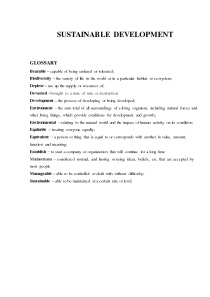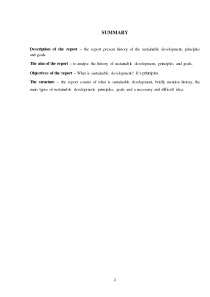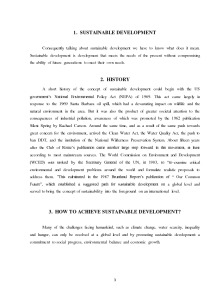Sustainable Development



Sustainable development. Glossary. Summary. The structure – the report consist of what is sustainable development, briefly mention history, the main types of sustainable development, principles, goals and a necessary and difficult idea. Sustainable development. Consequently talking about sustainable development we have to know what does it mean. How to achieve sustainable development? Many of the challenges facing humankind, such as climate change, water scarcity, inequality and hunger, can only be resolved at a global level and by promoting sustainable development a commitment to social progress, environmental balance and economic growth. Environmental sustainability. Economic sustainability. Principles of sustainable development. What are the sustainable development goals? Sustainable development goals. A necessary and difficult idea.
Biodiversity – the variety of life in the world or in a particular habitat or ecosystem;
Devasted – brought to a state of ruin or destruction
Environment – the sum total of all surroundings of a living organism, including natural forces and other living things, which provide conditions for development and growth;
Environmental – relating to the natural world and the impact of human activity on its condition;
Equivalent – a person or thing that is equal to or corresponds with another in value, amount, function and meaning;
Mainstream – considered normal, and having or using ideas, beliefs, etc. that are accepted by most people
Manageable – able to be controlled or dealt with without difficulty;
Sustainable – able to be maintained at a certain rate or level;
Description of the report – the report present history of the sustainable development, principles and goals.
The aim of the report – to analyse the history of sustainable development, principles and goals.
Objectives of the report – What is sustainable development? It’s principles.
The structure – the report consist of what is sustainable development, briefly mention history, the main types of sustainable development, principles, goals and a necessary and difficult idea.
Consequently talking about sustainable development we have to know what does it mean. Sustainable development is development that meets the needs of the present without compromising the ability of future generations to meet their own needs.
A short history of the concept of sustainable development could begin with the US government’s National Environmental Policy Act (NEPA) of 1969. This act came largely in response to the 1969 Santa Barbara oil spill, which had a devastating impact on wildlife and the natural environment in the area. But it was also the product of greater societal attention to the consequences of industrial pollution, awareness of which was promoted by the 1962 publication Silent Spring by Rachael Carson. Around the same time, and as a result of the same push towards great concern for the environment, arrived the Clean Water Act, the Water Quality Act, the push to ban DDT, and the institution of the National Wilderness Preservation System. About fifteen years after the Club of Rome’s publication came another large step forward in this movement, at least according to most mainstream sources. The World Commission on Environment and Development (WCED) was tasked by the Secretary General of the UN, in 1983, to “re-examine critical environmental and development problems around the world and formulate realistic proposals to address them. ”This culminated in the 1987 Bruntland Report’s publication of “ Our Common Future”, which established a suggested path for sustainable development on a global level and served to bring the concept of sustainability into the foreground on an international level.
- Environment Papers
- Microsoft Word 65 KB
- 2019 m.
- English
- 13 pages (3610 words)
- College
- Laura

















